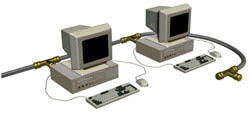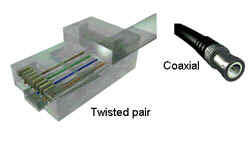NETWORKING
INTRODUCTION
PART 3
![]()
Overview
Twisted pair cables and coaxial cables are different types of cable that can be used to connect the equipment when creating the network. Twisted pair cable is easier to use.

Coaxial Cable
Coaxial cabling was used in Ethernet networks before twisted pair cabling. A coaxial network is created by joining sections of coaxial cable with T-pieces (or Y-pieces) to form a long segment. The two free ends of the segment are terminated (using end-pieces) and the PCs are connected to the T-pieces (or Y-pieces). Network information is sent along the segment, so that it reaches all devices.
The whole coaxial segment must remain intact for the network to operate. This means that if a section of cable is damaged or disconnected, the network is broken, making it unusable. Making changes to the network (such as adding new PCs) involves breaking the segment, which makes the network temporarily unusable (this is known as ‘network down-time’).
Coaxial cable can only be used for Ethernet (10Mbps) and cannot be used for Fast Ethernet (100Mbps).

Twisted Pair Cable
Twisted pair cabling is replacing coaxial cabling. It is now more commonly used because it is easier to use and more flexible than coaxial cable. As a result, the majority of Ethernet network equipment today has twisted pair connections (ports).
A small twisted pair network is typically created using a piece of networking equipment (such as a hub or switch) to which the PCs are connected with twisted pair cables. The networking equipment distributes the network information to the devices that are connected to it.
Twisted pair cable is very flexible and has easy-to-use connectors that simply slot into the ports on the devices and network equipment. If one of the twisted pair cables is damaged or disconnected, only that specific connection is broken; the rest of the network remains operational. Making changes to the network (such as adding new PCs) is easy and it can be done without affecting other devices on the network.
Category 5 cable (a high grade
of twisted pair cable) can also be used for Fast Ethernet, allowing for future network
expansion when changing from Ethernet to Fast Ethernet.
![]()
[Home] [Networking Intro] [Internet Intro] [Services]
[Design] [Engineering]
[Networking Deployment] [Benefits] [Pilots] [Library] [News]

